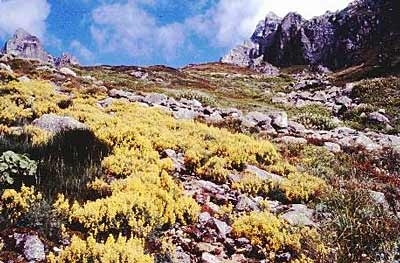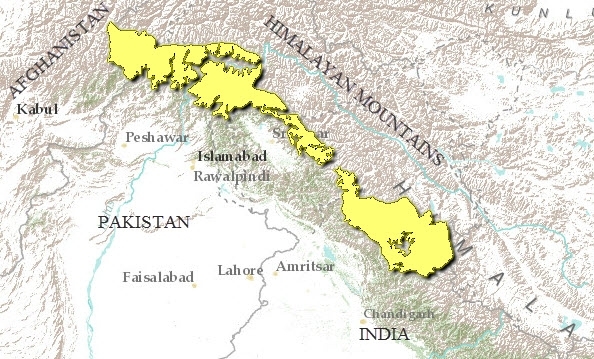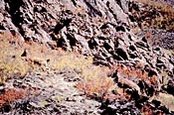Northwestern Himalayan alpine shrub and meadows
The remote Northwestern Himalayan Alpine Shrub and Meadows ecoregion is some of the most intact and undisturbed habitat for the snow leopard (Uncia uncia), the Himalayan high-altitude carnivore that hunts large mountain ungulates such as ibex (Capra ibex), markhor (Capra falconeri), blue sheep (Pseudois nayur), and tahr (Hemitragus jemlahicus). However, the snow leopard is not the lone predator here, for the ecoregion harbors the Tibetan wolf (Canis lupus) and large avian predators such as the lammergeier (Gypaetus barbatus) and golden eagle (Aquila chrysaetos), which soar high above the mountain peaks searching for colonial marmots (Marmota himalayana).
For a short time in late spring and summer, the meadows become resplendent with a colorful tapestry of delphiniums, gentians, poppies, roseroots, louseworts, anemones, and asters, to name but a few. No less bright are the flowers of the rhododendrons that characterize the alpine scrub habitat closer to the treeline. Within this species-rich landscape are hotspots of endemism, created by the varied topography, which results in very localized climatic variations, promoting the evolution of specialized plant communities.
Location and General Description
This ecoregion represents the alpine scrub and meadows between 3,300 and 3,600 meters (m) in the northwestern reaches of the Himalayan Range. The ecoregion extends across northwestern India and northern Pakistan, mostly in the Vale of Kashmir and associated [[mountain]s]. The vegetation consists of stunted, twisted krummholz, dominated by rhododendron and juniper scrub, interspersed with patches of birch forests. It also includes patches of moist scrub vegetation within some parts of the trans-Himalaya, such as Lahul Valley, the northwestern parts of the Pir Panjal Range, and adjacent areas in Pakistan.
The Himalayas trace their origin to the recent geological past when the collision between the northward drifting Deccan Plateau and the northern Eurasian continent took place. During this, and several subsequent periods of geological upheaval and uplift, the Himalayan Mountains were thrust upward and above the Tibetan Plateau, which represented the bottom of the Tethys Sea before the collision. Evidence suggests that this northwest region of the Himalaya is younger than the eastern extent of the mountain range.
Because the southwestern monsoon that sweeps in from the Bay of Bengal expends most of its precipitation in the eastern Himalayas, the western Himalayas are drier. Therefore, the ecoregion is arid to semi-arid, with littleprecipitation falling in the winter and spring. Ambient temperature approaches freezing during the winter, but summers are hot. In response to these dry and harsh climatic conditions, the treeline is almost 1,000 m lower in the western Himalayas than in the east.
Aspect is another important determinant of local climatic variation; the north-facing slopes are less exposed to sunlight and therefore are cooler and retain more moisture. But within this general trend, the complex topography also creates rainshadows, resulting in very localized climatic variations.
There are several vegetation types in this ecoregion. Closer to the timberline the vegetation consists of low near-evergreen scrub made up of a stunted birch-rhododendron community. Only five rhododendron species are reported from this belt, compared to more than sixty species known from the eastern Himalaya. Above this scrub is the alpine meadow, comprising a diverse herb community that includes species of Doronicum, Delphinium, Gentiana, Meconopsis, Pedicularis, Anemone, Aster, Polygonum, Primula, and Mertensia, among others. Scree habitat contains cushion-forming plants such as Caragana, Saxifraga, Draba, and Gypsophila. A high proportion of alpine and sub-alpine herbs in Fumariaceae, Primulaceae, Saxifragaceae, and Scrophulariaceae are endemic and several are endangered.
Biodiversity Features
Little information is available on the biodiversity of this remote and scientifically unexplored area. Although most of the faunal representatives in the high altitudes are small, the ecoregion contains several large mammals that are important for conservation and can be used as focal species. The snow leopard takes prominence, but a successful and comprehensive conservation program should also include the larger ungulates such as the markhor, Asiatic ibex, blue sheep, and argali that make up this predator's prey species. The ecoregion also represents the southernmost limit for the Asiatic ibex, which prefers drier scrub vegetation on steeper slopes adjacent to the trans-Himalaya. There is a distinct ecological separation between the Asiatic ibex and the Himalayan tahr, which prefer moister scrub and meadow vegetation in the southern slopes of the Greater Himalaya.
The known mammal fauna includes forty-nine species. None of the mammals are considered endemic to the ecoregion, but there are several threatened species, including the snow leopard, serow (Capricornis sumatraensis), markhor, Himalayan tahr, argali, Himalayan musk deer (Moschus chrysogaster), and brown bear (Ursus arctos).
The bird fauna consists of 139 species. None are endemic, but there are several characteristic Himalayan species such as the lammergeier, golden eagle, Himalayan griffon, snow partridge (Lerwa lerwa), Tibetan snowcock (Tetraogallus tibetanus), and Himalayan snowcock (Tetraogallus himalayensis), which should be focal species for conservation efforts.
Current Status
Because of its high elevation and harsh climate, as well as its lack of commercially valuable timber trees, the [[ecoregion]'s] habitat is relatively stable. There are fifteen protected areas that cover 4,500 square kilometers (km2) (10 percent) of the ecoregion (Table 1). Two of these - Siachu Tuan Nalla Wildlife Sanctuary and Pin Valley - are large, the latter exceeding 1,000 km2. Three other protected areas-Great Himalayan (690 km2), Kistar (1,260 km2), and Rupti Bhabha (850 km2)-that overlap with adjacent ecoregions are also large. But most of the others are small, with the average area of the protected areas being only 300 km2.
|
Table 1. Protected Areas That Overlap with the Ecoregion. Protected Area Area (km2) IUCN Category Chitral Gol National Park 110 II Gahriat Gol GR 140 Parit Gol GR 140 Baltal 150 IV Siachu Tuan Nalla WS 880 Manali WS 100 IV Pin Valley 1,190 II Kanawar 80 IV Great Himalayan (east) 200 II Great Himalayan (west) 320 II Kugti WS 160 IV Tundah WS 180 IV Kistar National Park 320 II Overa-Aru 180 IV Rupti Bhabha 350 IV Total 4,500 (Northwestern Himalayan alpine shrub and meadows) Types and Severity of ThreatsThe threats to the natural habitat in this ecoregion stem largely from overgrazing by domestic livestock and fuelwood collection. Already, all lands that can support agriculture (i.e., alluvial fans and valleys) have been cleared and cultivated. Commercial harvest of wild medicinal herbs in many areas of western Himalayas also is a major threat. Additional information on this ecoregion
Further Reading
| |||



1 Comment
Vinay Tandon wrote: 09-22-2010 03:52:58
The Protected Areas shown need to be updated, both names and area. Type and Severity of threats can be further elucidated. i can do some of this but need to know how to go about it.